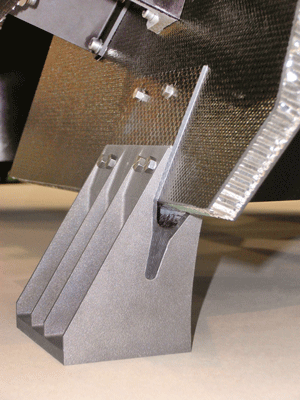Airbus satellite bracket production optimised by Additive Manufacturing
September 9, 2014
Airbus Defence and Space is using Additive Manufacturing equipment from EOS to produce satellite retaining brackets at its Competence Centre for Composite Materials in Madrid, Spain.

One of the AM titanium brackets, made in an
EOSINT M 280, that connects the body of a satellite
with the carbon fibre panel of the reflectors and
feeder facilities at the upper end (Courtesy EOS)
The current generation of satellites include metal brackets that serve as a link between the body of a satellite and the carbon fibre reflectors and feed array mounted at the upper end. The brackets must fix securely to the satellite body and withstand high thermal stresses caused by extreme temperature fluctuations in space, ranging from -180°C to +150°C.
Titanium is preferable for such applications due to its thermal conductivity properties and high strength-to-weight ratio. The latter is especially important, as every kilogram carried into space costs many thousands of dollars, often running into six figures depending on the carrier system and the orbit to be reached.
Brackets manufactured by conventional metal cutting did not meet the requirements of Airbus Defence and Space, as design limitations prevented optimisation of the weight of the component and the stresses.
Additive manufacturing technology was selected as an alternative production method. The bracket is built up from successive layers of metal powder that are melted and hardened by a laser beam driven by data that originates from the CAD model of the part. Titanium is still usable as a tried and tested material and the process allows the design of components to be adapted easily.
“Additive manufacture has two main advantages. We are not only able to optimise the design of parts but can also produce them in one piece,” stated Otilia Castro Matías, who is responsible for antennae at Airbus Defence and Space in Madrid. “When the precision workpiece is complete, no excess material remains except for raw titanium powder that can be reused in our EOSINT M 280.”
The new devices meet all expectations of the experts involved. Most important of all is the improved temperature resistance of the entire structure, which now can easily and permanently withstand a 330°C temperature variation under a force of 20 kN. In addition, production time for the three brackets required for each satellite has been reduced by five days to less than one month.
“Thanks to Additive Manufacturing, we were able to redesign the bracket and eliminate the vulnerability caused by thermal stress at the interface with the carbon fibre panel. The improvements also significantly reduced thermally induced failure during the qualification test campaign. The cost of space activities is relatively high, so it is especially important to protect any hardware from possible failure,” added Matías.
The European Space Agency (ESA) has also supported this program, the successful completion of which allows further use of this efficient production technology in the field of aerospace.
“Additive Manufacturing brought measurable benefits to critical aspects of the project without requiring cuts to be made elsewhere, so there were no compromises – something engineers don’t get to hear very often. In addition, cost savings in bracket production amounted to more than 20% and the weight was reduced by about 300 g, which means a saving of nearly one kg per satellite.”
Airbus Defence and Space, a division of Airbus Group, was formed on 1st January 2014 by combining the business activities of Cassidian, Astrium and Airbus Military. The new division is Europe’s number one defence and space enterprise and the second largest space business worldwide.
www.eos.info
www.airbusdefenceandspace.com
Subscribe to our FREE e-newsletter
Useful links: News | Articles | Introduction to metal Additive Manufacturing
















